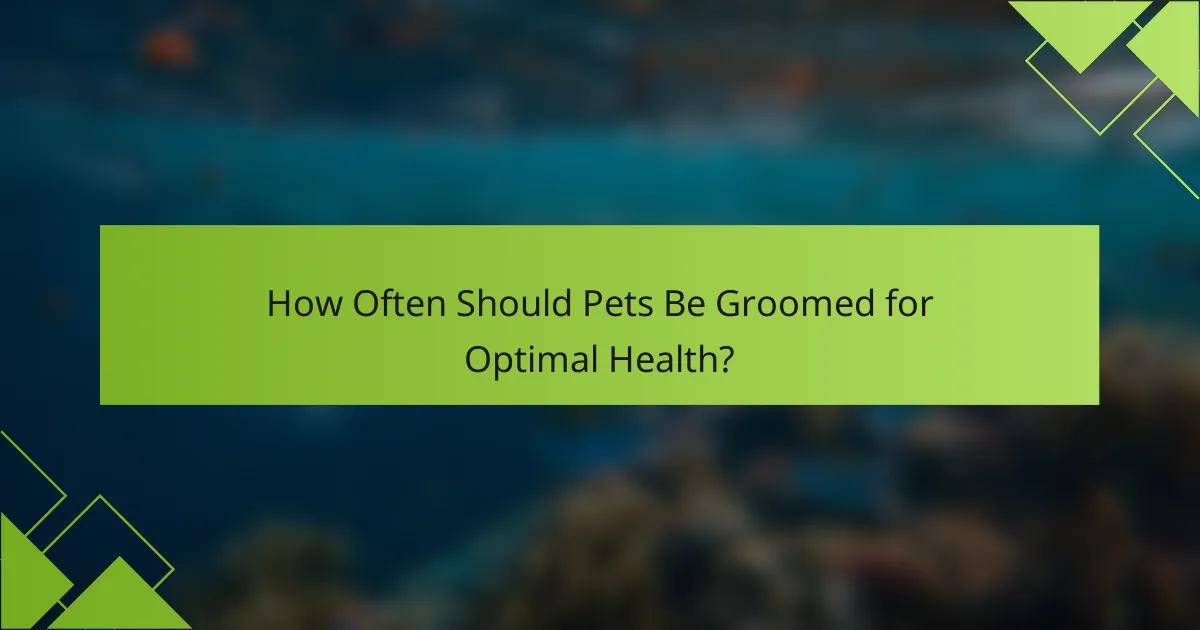Regular pet grooming is crucial for maintaining your pet’s health and well-being. It prevents skin infections, reduces shedding, and allows for early detection of health issues. Grooming also enhances circulation and promotes a shiny coat. Additionally, it strengthens the bond between pets and their owners, contributing to emotional stability and reduced stress.

Why is Regular Pet Grooming Important for Health?
Regular pet grooming is essential for maintaining overall health. It prevents matting, reduces the risk of skin infections, and promotes circulation. Regular grooming also allows for early detection of health issues like lumps or skin conditions. Additionally, it enhances the bond between pet and owner, contributing to the pet’s emotional well-being.
What Are the General Health Benefits of Grooming Pets?
Regular pet grooming significantly enhances overall health by preventing skin issues, promoting cleanliness, and fostering emotional well-being. Grooming removes dirt, debris, and loose fur, reducing the risk of infections. It also allows for early detection of health problems, such as lumps or skin irritations. Additionally, grooming strengthens the bond between pets and their owners, contributing to better mental health for both. Regular grooming sessions can lead to a more comfortable and happier pet, improving their quality of life.
How Does Grooming Impact Pet Hygiene and Cleanliness?
Regular pet grooming significantly enhances hygiene and cleanliness. It reduces the risk of skin infections, minimizes shedding, and eliminates parasites. Regular grooming also promotes better air circulation to the skin, which is essential for maintaining a healthy coat.
Additionally, grooming sessions provide an opportunity to inspect pets for abnormalities, such as lumps or skin irritations. This proactive approach can lead to early detection of health issues, ensuring timely veterinary care. Regular grooming contributes to a pet’s overall well-being, making it a vital aspect of responsible pet ownership.
Why Does Grooming Reduce the Risk of Health Issues?
Regular pet grooming significantly reduces the risk of health issues. It helps prevent matting, which can lead to skin infections. Grooming also allows for early detection of parasites, such as fleas and ticks. Additionally, it promotes better circulation and skin health by removing dead hair and dirt. Regular grooming can improve the pet’s overall hygiene and comfort, reducing stress and anxiety related to poor coat condition.

What Specific Benefits Does Grooming Provide for Different Pet Types?
Regular pet grooming provides numerous health benefits across different pet types. It enhances hygiene, reduces the risk of health issues, and promotes overall well-being.
For dogs, grooming helps prevent matting and skin infections, and it allows for early detection of parasites. Cats benefit from reduced hairballs and improved coat condition. Small mammals, like rabbits and guinea pigs, require grooming to prevent fur matting and maintain dental health. Birds benefit from feather maintenance, which aids in flight and overall comfort. Regular grooming also strengthens the bond between pets and their owners, enhancing emotional health.
How Does Grooming Benefit Dogs Specifically?
Regular grooming significantly enhances a dog’s health by preventing various issues. It helps maintain a clean coat, reducing the risk of skin infections and matting. Grooming also promotes better circulation through regular brushing, which can lead to healthier skin. Furthermore, it allows for early detection of abnormalities, such as lumps or parasites, contributing to proactive health management. Regular grooming sessions create a bonding experience, reducing stress and anxiety for both the dog and the owner.
What Are the Unique Grooming Needs of Cats?
Cats have unique grooming needs that differ from other pets. Regular grooming helps maintain their coat, reduces shedding, and prevents matting. It also promotes skin health by distributing natural oils, reducing the risk of skin infections. Additionally, grooming provides an opportunity to check for parasites and skin abnormalities, enhancing overall health. Regular grooming can be particularly beneficial for long-haired breeds, as they require more maintenance to avoid tangles and discomfort.
Which Small Animals Require Regular Grooming?
Small animals that require regular grooming include rabbits, guinea pigs, hamsters, ferrets, and certain breeds of mice. Regular grooming promotes health by preventing matting, reducing the risk of skin issues, and maintaining hygiene. For instance, long-haired rabbits need frequent brushing to avoid fur tangles. Regular grooming also enhances bonding between pet and owner, contributing to overall well-being.

How Can Regular Grooming Improve Pet Behavior?
Regular grooming can significantly enhance pet behavior by promoting comfort and reducing stress. Grooming sessions create a routine that helps pets feel secure and relaxed. Additionally, regular grooming can prevent matting and skin issues, which can lead to discomfort and irritability.
A well-groomed pet is often more sociable and less prone to behavioral problems such as aggression or anxiety. This is particularly true for breeds that require frequent grooming. Furthermore, grooming allows for early detection of health issues, contributing to overall well-being.
Establishing a grooming routine can also strengthen the bond between pet and owner, leading to improved behavior. Pets that associate grooming with positive experiences are likely to exhibit better manners and responsiveness.
What Role Does Grooming Play in Strengthening the Human-Pet Bond?
Regular pet grooming significantly enhances the bond between humans and their pets. It promotes physical health, improves emotional well-being, and strengthens trust. Grooming sessions offer quality time, fostering connection through touch and attention.
Regular grooming helps prevent health issues like matting, skin infections, and parasites. It allows for early detection of potential health problems, such as lumps or skin irritations. Additionally, grooming can reduce anxiety in pets, making them more comfortable around their owners.
The unique attribute of grooming is that it creates a routine, which pets often thrive on. This consistency can lead to increased security and trust in their human companions. As a result, both pets and owners experience a deeper emotional connection.
In conclusion, regular grooming serves as a vital practice for maintaining pet health and enhancing the human-pet bond. The act of grooming not only benefits physical health but also nurtures emotional ties, reinforcing the relationship between pets and their owners.
How Can Grooming Help in Identifying Health Problems Early?
Regular pet grooming can help identify health problems early by revealing skin issues, parasites, or unusual lumps. Grooming sessions allow for close examination of a pet’s body, facilitating timely detection of conditions such as allergies or infections. For instance, noticing changes in fur texture or skin condition can indicate underlying health concerns. Early intervention often leads to better outcomes, emphasizing the importance of routine grooming for overall pet health.

What Are the Psychological Benefits of Grooming for Pets?
Regular pet grooming provides significant psychological benefits, enhancing both the pet’s and owner’s well-being. Grooming fosters a sense of security and comfort for pets, reducing anxiety and stress. It strengthens the bond between pet and owner, promoting trust and affection. Additionally, regular grooming can improve the pet’s mood and overall happiness, leading to a more harmonious home environment. Engaging in grooming routines can also serve as a source of joy and relaxation for pet owners, contributing positively to their mental health.
How Does Grooming Contribute to a Pet’s Emotional Well-being?
Regular pet grooming significantly enhances a pet’s emotional well-being. It fosters a sense of security and comfort, reducing anxiety and stress. Grooming sessions create bonding opportunities between pets and their owners, strengthening their emotional connection. Additionally, regular grooming helps detect health issues early, contributing to overall happiness.
Which Grooming Techniques Help Reduce Pet Anxiety?
Regular grooming techniques significantly reduce pet anxiety by promoting comfort and trust. Techniques like brushing, bathing, and nail trimming provide physical touch that calms pets. Regular grooming also helps identify health issues early, contributing to overall well-being. Additionally, the routine creates a predictable environment, further easing anxiety.

What Tools and Products Are Essential for Effective Pet Grooming?
Regular pet grooming is essential for maintaining your pet’s health. It helps prevent skin issues, reduces shedding, and promotes a healthy coat. Grooming also allows for early detection of health problems, such as lumps or parasites.
Key tools for effective grooming include brushes, combs, nail clippers, and shampoos. Each tool serves specific purposes, like detangling fur or maintaining nail length. Regular grooming sessions can enhance your pet’s comfort and overall well-being.
The benefits of grooming extend to emotional health as well. It fosters bonding between pet and owner, reducing anxiety and stress. Regular grooming can lead to a happier, healthier pet.
Which Grooming Tools Are Best for Dogs?
Regular grooming tools are essential for maintaining a dog’s health and well-being. These tools help prevent matting, reduce shedding, and promote skin health. Regular grooming also allows for early detection of health issues like skin infections or parasites.
Key grooming tools include brushes, combs, nail clippers, and grooming gloves. Each tool serves a unique purpose, such as removing loose fur or trimming nails. A good grooming routine can enhance a dog’s overall appearance and comfort, leading to a happier pet.
Investing in quality grooming tools ensures effective care and strengthens the bond between pet and owner. Regular grooming contributes to a dog’s hygiene and can improve their behavior and socialization skills.
What Products Should Cat Owners Consider for Grooming?
Cat owners should consider brushes, combs, nail clippers, and grooming wipes for effective grooming. Regular grooming prevents matting, reduces shedding, and maintains skin health.
| Product | Benefits | Recommended Use |
|——————|———————————–|———————–|
| Brushes | Removes loose fur, prevents mats | Daily or weekly |
| Combs | Untangles fur, removes debris | Weekly |
| Nail Clippers | Maintains nail length, prevents injury | Monthly |
| Grooming Wipes | Cleans fur, freshens scent | As needed |

How Often Should Pets Be Groomed for Optimal Health?
Pets should be groomed regularly to maintain optimal health, ideally every 4 to 6 weeks. Regular grooming offers numerous health benefits, including the prevention of matting, reduction of skin infections, and early detection of parasites or abnormalities. Grooming also promotes better circulation and skin health through the removal of dead hair and dirt. For specific breeds, grooming frequency may vary; some may require more frequent attention due to their coat type. Overall, consistent grooming contributes significantly to a pet’s overall well-being and comfort.
What Factors Influence the Frequency of Grooming?
Regular pet grooming frequency is influenced by factors such as breed, coat type, and health needs. Different breeds require varying grooming schedules; for instance, long-haired breeds often need more frequent grooming. Coat type also plays a significant role; curly coats may mat without regular maintenance. Additionally, health conditions like skin issues or allergies may necessitate more frequent grooming to ensure comfort and hygiene. Regular grooming promotes overall health by reducing the risk of parasites and skin infections.
How Can Seasonal Changes Affect Grooming Needs?
Seasonal changes significantly impact grooming needs for pets. As temperatures fluctuate, pets may require more frequent grooming to manage shedding and maintain skin health.
In warmer months, pets shed their winter coats, necessitating regular brushing to reduce hair around the home and prevent matting. This grooming helps distribute natural oils, promoting a healthy coat.
During colder months, pets may need grooming to prevent matting and skin irritation caused by moisture and debris trapped in their fur. Regular grooming also allows for early detection of skin issues or parasites, ensuring timely treatment.
Overall, adapting grooming routines to seasonal changes enhances pet health and comfort.

What Common Mistakes Should Pet Owners Avoid When Grooming?
Pet owners should avoid several common grooming mistakes to maintain their pet’s health. Neglecting regular grooming can lead to matting, skin infections, and discomfort. Over-bathing can strip natural oils, causing skin issues. Using inappropriate tools may hurt the pet or fail to remove loose fur effectively. Ignoring specific breed needs can result in inadequate care. Lastly, skipping vet consultations for grooming advice can lead to missed health concerns.
How Can Improper Grooming Techniques Harm Pets?
Improper grooming techniques can significantly harm pets by causing physical and emotional distress. Neglecting regular grooming can lead to matting, skin infections, and discomfort. For example, matted fur traps moisture and dirt, leading to skin irritations. Additionally, improper nail trimming can result in painful injuries. Regular grooming promotes overall health, reduces anxiety, and enhances the bond between pets and their owners.
What Should Pet Owners Know About Grooming Sensitive Areas?
Regular grooming of sensitive areas is essential for a pet’s health. It helps prevent skin irritations, infections, and matting. Regular grooming promotes good hygiene, enhances circulation, and reduces shedding. It also allows pet owners to identify any unusual lumps or skin conditions early. Additionally, grooming sensitive areas can improve the bond between pet and owner, making the pet feel more comfortable and secure.

What Are Expert Tips for Effective Pet Grooming?
Regular pet grooming significantly enhances your pet’s health by preventing various issues. It helps reduce shedding, prevents matting, and allows for early detection of skin problems or parasites. Regular grooming also promotes better blood circulation and can lead to a shinier coat. Additionally, it strengthens the bond between pet and owner. Regular grooming sessions can also reduce stress and anxiety in pets, contributing to their overall well-being.
Which Best Practices Should Pet Owners Follow for Safe Grooming?
Regular grooming is essential for pet health, ensuring cleanliness and preventing health issues. Best practices include regular brushing to reduce shedding and matting, bathing with pet-safe products to maintain skin health, and trimming nails to prevent discomfort. Additionally, regular ear cleaning helps avoid infections while checking for skin abnormalities promotes early detection of potential issues. These practices contribute to a pet’s overall well-being and comfort.
How Can Pet Owners Create a Positive Grooming Experience?
Regular pet grooming enhances health by preventing matting, reducing skin issues, and promoting good hygiene. A positive grooming experience can be created by establishing a routine, using gentle techniques, and providing rewards.
1. Establish a routine: Consistency helps pets become familiar with grooming, reducing anxiety.
2. Use proper tools: Select brushes and clippers suitable for the pet’s coat type to ensure comfort.
3. Create a calm environment: Minimize distractions and use soothing tones to ease the pet’s nerves.
4. Reward positive behavior: Offer treats or praise to reinforce good grooming experiences.
These practices contribute to the overall well-being of pets, making grooming a beneficial activity.
What Resources Are Available for Learning Grooming Techniques?
Regular pet grooming enhances health and hygiene through various resources. Online tutorials, grooming classes, and instructional books provide valuable insights into effective techniques. Local pet groomers often offer workshops that teach skills hands-on. Additionally, veterinary clinics may host seminars focusing on the health benefits of grooming, such as preventing skin issues and detecting health problems early. Engaging with these resources equips pet owners with the knowledge to maintain their pets’ well-being effectively.
